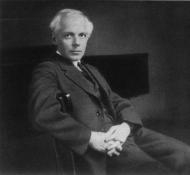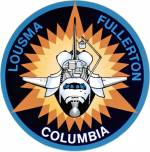STS-3 was NASA's third Space Shuttle mission, and was the third mission for the Space Shuttle
Columbia. It launched on 22 March 1982, and landed eight days later on 30 March. STS-3 was the first shuttle launch with an unpainted external tank, and the only mission to land at the White Sands Space Harbor near Las Cruces, New Mexico.
Mission summaryColumbia was launched from Kennedy Space Center at 11:00 am EST, on 22 March 1982, the planned launch date. The launch was delayed by one hour due to the failure of a heater on a nitrogen-gas ground support line. Prior to the launch, Columbia had spent only 70 days in the Orbiter Processing Facility—a record checkout time. The two-man crew consisted of Jack R. Lousma, commander, and C. Gordon Fullerton, pilot.
The primary objectives of the flight were to continue testing the "Canadarm" Remote Manipulator System (RMS), and to carry out extensive thermal testing of
Columbia by exposing its tail, nose and top to the Sun for varying periods of time. The crew found that prolonged exposure to the Sun caused the cargo bay doors to warp slightly and not close. Rolling the orbiter to balance temperatures around the orbiter resolved the issue.
In addition, in its payload bay, Columbia again carried the DFI package, and OSS-l (named for the NASA Office of Space Science and Applications) which consisted of a number of instruments mounted on a Spacelab pallet, intended to obtain data on the near-Earth environment and the extent of contamination caused by the orbiter itself. A test canister for the Small Self-Contained Payload program - also known as the Getaway Special (GAS) – was mounted on one side of the payload bay.
For the first time, a number of experiments were carried in the shuttle's mid-deck lockers. These included a Continuous Flow Electrophoresis System experiment to study the separation of biological components, and a Mono-disperse Latex Reactor experiment, to produce uniform micrometre-sized latex particles. The first Shuttle Student Involvement Project (SSIP) – a study of insect motion - also was carried in a mid-deck locker.
A variety of minor problems were experienced during the flight. The orbiter's toilet malfunctioned on first use resulting in, according to Lousma, "eight days of colorful flushing"; one Auxiliary Power Unit (APU) overheated (but worked properly during descent); both crew members experienced some space sickness; and on 26 March, three communications links were lost.
STS-3 was planned as a 7-day flight. The landing was moved to Northrop Strip (later renamed White Sands Space Harbor) at White Sands Missile Range, New Mexico. since the planned landing site at Edwards Air Force Base had flooded due to excessive rain. Lousma and Fullerton chose to land at White Sands instead of the new Shuttle Landing Facility at Kennedy Space Center because they had trained there. A large-scale equipment movement (reportedly "40 train carloads") from Edwards AFB to White Sands was undertaken before and during the mission, to ensure that a landing could be fully supported. Although time-sensitive equipment movements of this nature were originally to be handled by Air Force cargo planes, NASA altered those plans and moved the equipment in two dedicated trains over the 1,000-mile distance via the Santa Fe Railroad and the Southern Pacific Railroad. The choice to move the support equipment by rail saved NASA $2 million in transportation costs. High winds at White Sands reduced visibility and delayed the landing by a day. As all mission objectives had been accomplished, the crew enjoyed what Lousma described as "an extra day in our world’s favorite vacation spot ... We finally had a chance to look out the window and enjoy being there."
Touchdown finally took place at 9:05 am MST, 30 March 1982, at Northrop Strip. STS-3 was the only shuttle mission to land at White Sands. The final approach was in part flown by the shuttle's autopilot, but the autoland program was not complete, and it was not meant to be an automatic landing. Rolling out on finals, the autopilot was reengaged, and responded by closing the speedbrakes (despite the orbiter being on profile), resulting in increased speed. The autopilot then commanded full speedbrakes, and kept oscillating like this for some time. Lousma left the autopilot activated in order to gather data on its behaviour, but disconnected it again at a very late stage to touch down manually. The landing was also one of the more dramatic of the program, with the landing gear deploying at 150 feet at 275kts, locked just 5 seconds before touch down, and the nose being raised again right before nose-gear touchdown. The landing demonstrated that the shuttle could land in the desert, but sand damaged the orbiter.
Columbia made 130 orbits and traveled 3,300,000 miles (5,300,000 km) during its 8-day, 4-minute, 45-second flight. A total of 36 thermal protection tiles were lost and 19 were damaged. The orbiter was returned to KSC on 6 April 1982. STS-3 was the last mission for which NASA named a complete full-time backup crew.
While on a post-mission goodwill tour in Beijing, Lousma displayed a photo he had taken from space of a "beautiful emerald-colored lake" in China and was surprised by the audience reaction. He later learned that the picture was likely of a secret atomic test site for the Chinese nuclear weapons program.


























